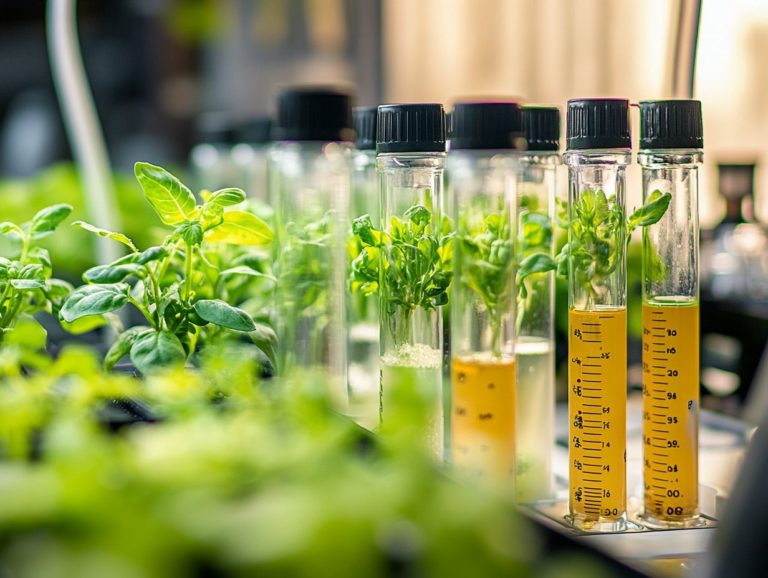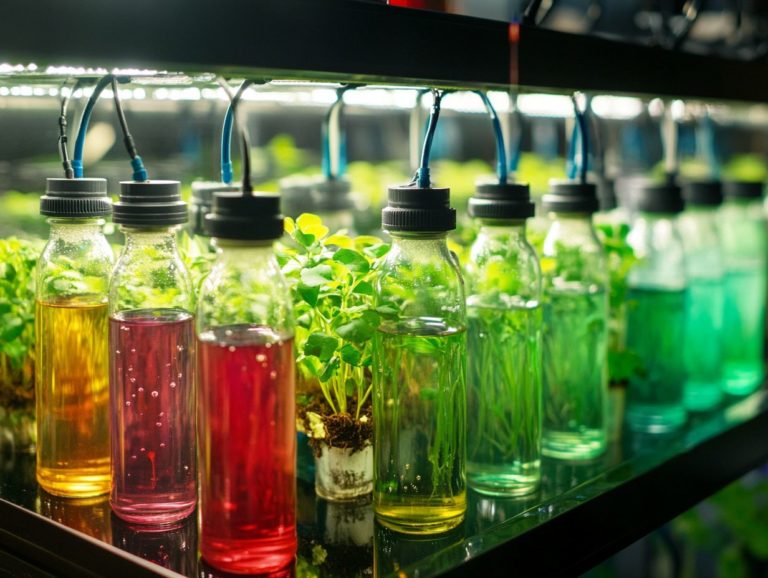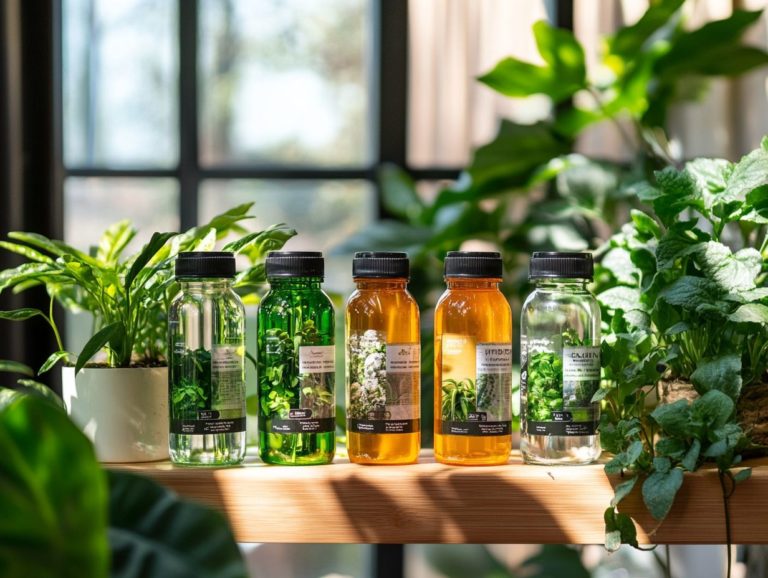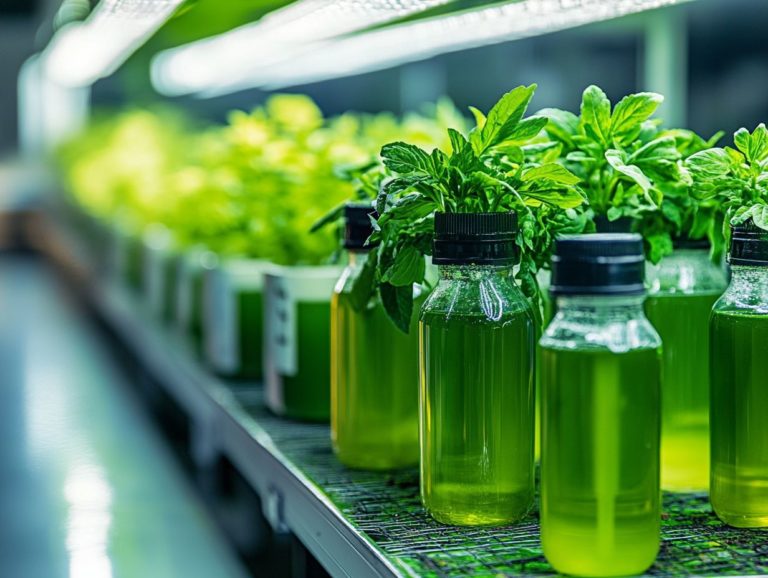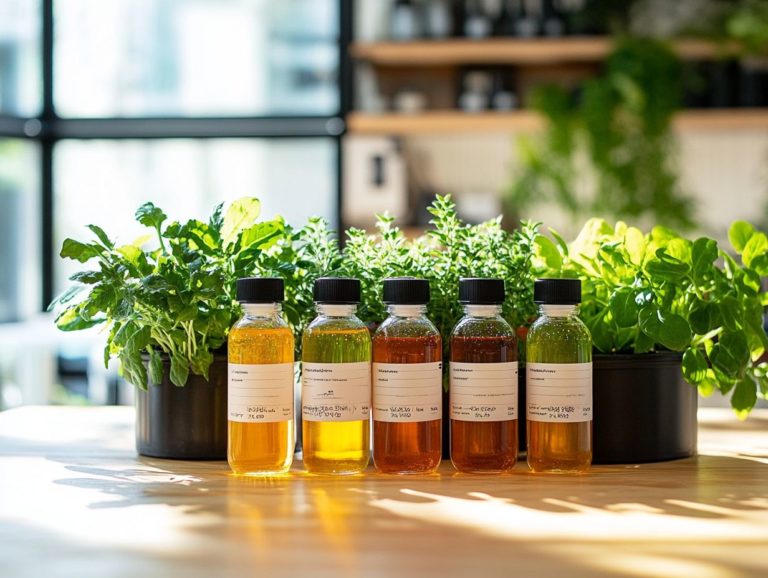Top 10 Nutrient Mistakes in Hydroponic Gardening
Hydroponic gardening has the potential to produce vibrant, healthy plants, yet many growers encounter common nutrient pitfalls along the way.
Let s explore the top 10 mistakes that can sabotage your hydroponic success, covering everything from insufficient lighting and improper nutrient selections to overlooking acid-base balance and maintaining environmental cleanliness.
Understanding these missteps is essential for optimizing plant health and maximizing yield. By recognizing these errors, you ll be well-equipped to cultivate thriving hydroponic gardens, whether you’re a seasoned expert or just starting your journey.
Contents
- Key Takeaways:
- 1. Not Providing Enough Light for Plants
- 2. Using the Wrong Nutrients for the Crop
- 3. Not Checking pH Levels Regularly
- 4. Overlooking the Importance of Oxygenation
- 5. Not Rotating Nutrient Solutions
- 6. Using Tap Water Instead of Filtered Water
- 7. Not Adjusting Nutrient Levels for Different Growth Stages
- 8. Not Using the Recommended Nutrient Dosage
- 9. Not Keeping Track of Nutrient Solution Temperature and Humidity Control
- 10. Not Maintaining a Clean and Sterile Environment
- How Do Nutrients Work in Hydroponic Gardening?
- What Are the Different Types of Nutrients Used in Hydroponic Gardening?
- What Are the Most Common Nutrient Deficiencies in Hydroponic Plants?
- How Can One Ensure Proper Nutrient Uptake in Hydroponic Plants?
- What Are the Benefits of Using Organic Nutrients in Hydroponic Gardening?
- How Can One Troubleshoot Nutrient Problems in Hydroponic Gardening?
- Frequently Asked Questions
- 1. What are the top 10 nutrient mistakes in hydroponic gardening?
- 2. Why is using incorrect nutrient ratios a common mistake in hydroponic gardening?
- 3. How does monitoring pH levels impact plant growth in hydroponic gardening and what are its implications for hydroponic systems?
- 4. What are the consequences of over or underfeeding plants in hydroponic gardening, and how can common mistakes be avoided?
- 5. Can using low-quality nutrients affect plant growth in hydroponic gardening, and what are the implications for sanitation practices?
- 6. How does oxygen play a role in hydroponic gardening, particularly in relation to root rot and nutrient management?
Key Takeaways:
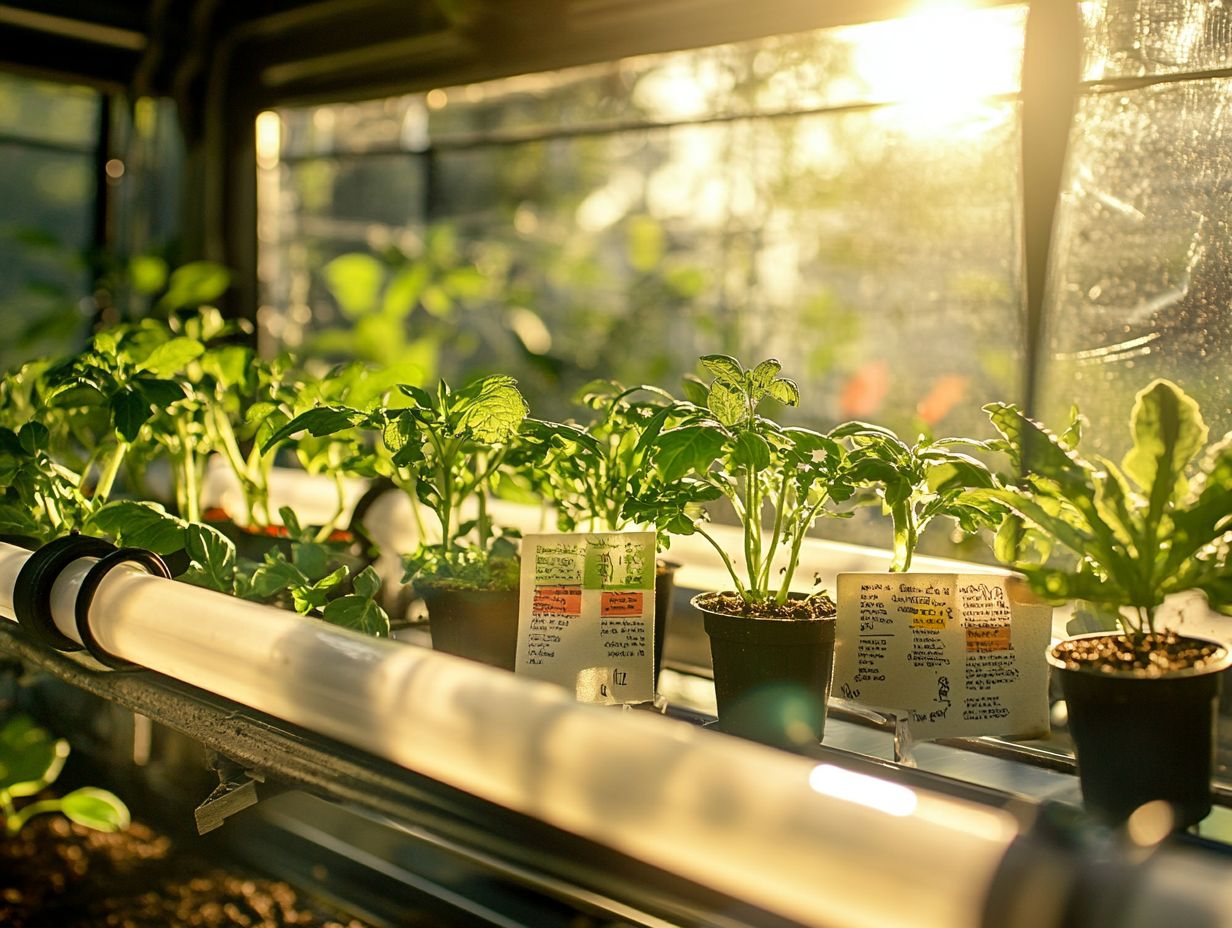
- If you don t provide enough light, your plants will struggle to grow!
- Using the wrong nutrients can cause nutrient deficiencies and impact plant health, highlighting the importance of nutrient management.
- Regularly checking acid-base levels is crucial for proper nutrient absorption and avoiding when plants can’t absorb nutrients.
1. Not Providing Enough Light for Plants
In hydroponic gardening, providing adequate lighting is essential for the best plant growth. If the light is insufficient, you may find your plants stunted and yields disappointing.
The right lighting supports photosynthesis, which is the process by which plants make their food using sunlight. It also plays a vital role in the overall health and vigor of your hydroponic crops.
You have a range of grow lights at your disposal, including LED, fluorescent, and HID lamps. Each offers different light spectrums and intensities tailored to meet diverse plant needs.
Light intensity significantly impacts plant physiology; too little can hinder growth, while too much can lead to leaf burn. Insufficient lighting often paves the way for common plant diseases like chlorosis where leaves yellow due to nutrient deficiencies and root rot, which thrives in dim conditions.
When selecting optimal lighting, consider the specific needs of the plants you re growing and the size of your hydroponic system. Adjusting the height of the lights and using timers to simulate natural day cycles are crucial steps to ensure robust growth and prevent disease.
2. Using the Wrong Nutrients for the Crop
Using the wrong nutrients for your specific crops can dramatically stifle plant growth and yield in hydroponic gardening. It s crucial to understand the nuances of nutrient management and the importance of tailoring nutrient balance to your crop selection.
Each hydroponic crop demands its own unique nutrient solution, as their growth stages and metabolic needs differ significantly. Essential elements like nitrogen, phosphorus, and potassium are pivotal in plant development. Nitrogen encourages lush, leafy growth, phosphorus nurtures strong roots and supports blooming, while potassium boosts overall vigor and enhances disease resistance.
When nutrient deficiencies arise, you might observe stunted growth, yellowing leaves, or lackluster fruit quality. To counter these challenges, adjusting fertilizer concentrations and ratios according to the specific needs of each crop is essential. This ensures that every plant receives the necessary nutrients for optimal health and productivity.
3. Not Checking pH Levels Regularly
Regularly checking pH levels is essential in hydroponic gardening. When the pH is off, you risk nutrient lockout, which can hinder plant growth and lead to deficiencies that jeopardize the overall health of your crops.
By maintaining the right acid-base balance, you ensure that vital nutrients remain accessible to your plants, paving the way for optimal growth and productivity. A pH meter becomes your best friend in this endeavor, providing precise readings that make monitoring and adjusting pH levels straightforward.
Using it is easy: calibrate the meter following the manufacturer s instructions, submerge the probe in your nutrient solution, and check the displayed value.
Ignoring pH levels can lead to serious consequences. Your plants may struggle, display stunted growth, or even succumb to imbalance, putting your entire yield and investment in the hydroponic system at risk.
Start your hydroponic journey today and watch your plants thrive!
4. Overlooking the Importance of Oxygenation
Proper oxygenation is often an overlooked aspect of hydroponic systems. Yet, it is crucial for maintaining healthy oxygen levels, preventing root rot, and ensuring optimal plant growth through effective air circulation and ventilation.
You can enhance oxygenation in your nutrient solution through several methods, such as using air stones, diffusers, and air pumps. By incorporating air pumps, you infuse oxygen directly into the water, creating a dynamic environment for your root systems.
This increased oxygenation promotes robust root health and reduces risks associated with low oxygen levels, like root diseases that can severely compromise plant vitality.
A thriving root zone is directly linked to improved nutrient uptake, resulting in healthier plants with better yields and greater resilience against pests and pathogens.
5. Not Rotating Nutrient Solutions
Not rotating your nutrient solutions can lead to stagnant conditions that encourage algae growth and create nutrient imbalances. This makes nutrient management essential for successful hydroponic gardening.
Regularly updating your nutrient solutions is key to maintaining a balanced environment that allows your plants to thrive. It ensures they receive vital minerals for robust development.
To combat algae build-up, keep your nutrient reservoirs clean and free from contaminants. Establish a regular cleaning schedule with non-toxic solutions to eliminate residues that attract unwanted growth.
Cover your reservoirs with opaque materials to block light, a significant contributor to algae proliferation. Monitor water temperature as it helps mitigate stagnant conditions, ultimately supporting optimal plant health and impressive yields.
6. Using Tap Water Instead of Filtered Water
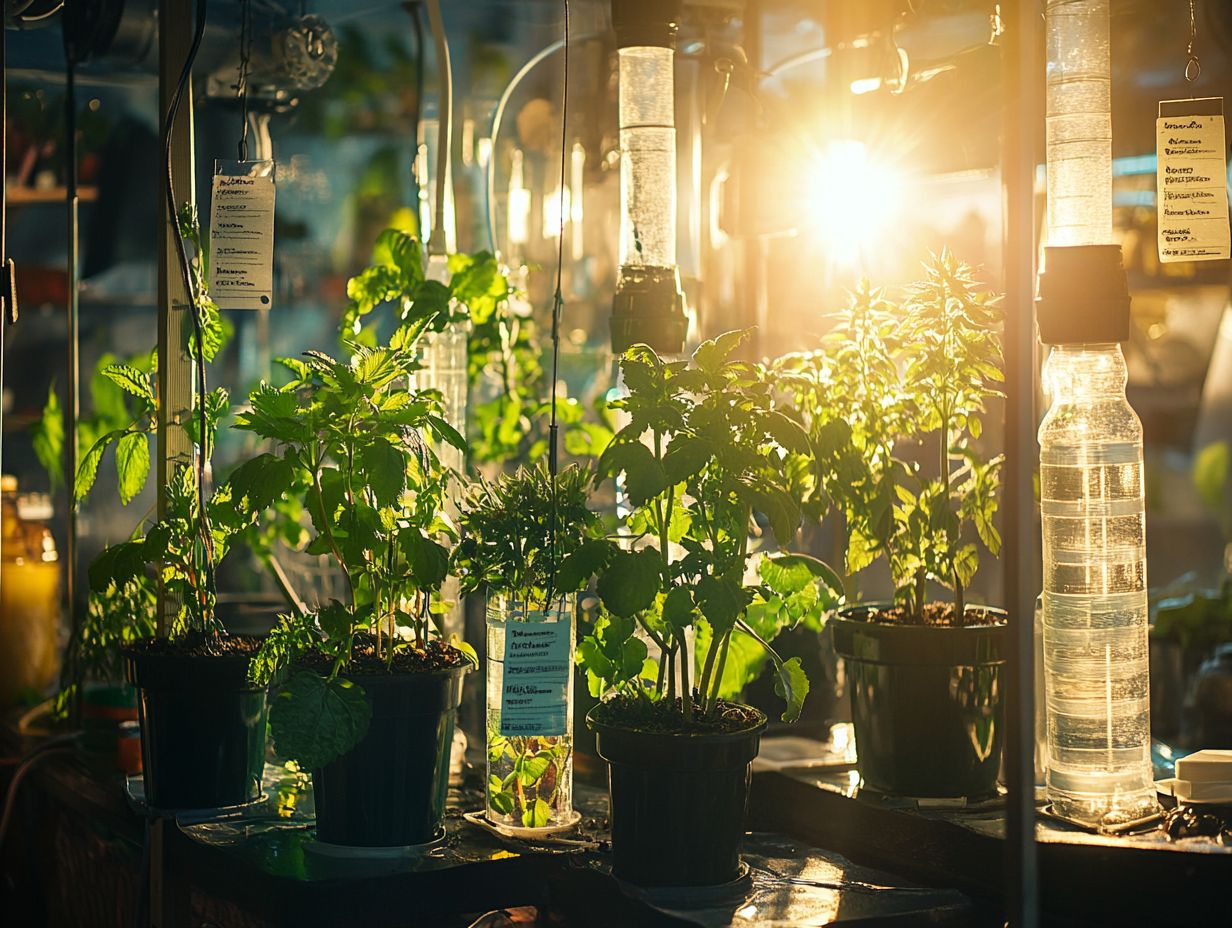
Using tap water instead of filtered water in your hydroponic systems can introduce chlorine and other contaminants. This disrupts nutrient absorption, compromising plant health and growth.
The purity of water directly influences how effectively your plants can utilize the nutrients in hydroponic solutions. Excessive impurities can stifle root development and lead to nutrient lockout (the inability of plants to absorb nutrients), ultimately diminishing both yield and quality.
Create optimal conditions by using clean, filtered water tested for pH levels and dissolved solids. This practice cultivates a more productive growing environment, enhancing plant vitality and resulting in healthier, more vigorous crops.
7. Not Adjusting Nutrient Levels for Different Growth Stages
Adjusting nutrient levels for different growth stages is vital in hydroponic gardening. Understanding that plants have varying nutrient needs can significantly impact their development and yield, making effective nutrient management essential for successful crop selection.
Take the germination phase: seeds thrive on a balanced mix of macronutrients like nitrogen, phosphorus, and potassium to kickstart early root and shoot development. As plants transition into the vegetative stage, their nitrogen demand ramps up, fostering lush leafy growth and sturdy stems.
Upon entering the flowering phase, the focus shifts to phosphorus and potassium, crucial for bud formation and enhancing flower quality. Neglecting these specific nutrient requirements can spell disaster, leading to deficiencies that result in stunted growth, lackluster flowering, or even plant mortality.
Custom nutrient solutions are the secret to thriving plants! Tailoring your nutrient approach during each critical growth phase ensures your plants achieve their full potential.
8. Not Using the Recommended Nutrient Dosage
Failing to use the recommended nutrient dosage can throw your hydroponic system into disarray. This leads to imbalances in the nutrient solution that hinder plant growth and diminish overall crop yield.
Without careful monitoring and strict adherence to these guidelines, you may unintentionally introduce complications such as stunted growth or unsightly leaf discoloration. Over-fertilization can cause nutrient burn, while under-fertilization could leave your plants weak and vulnerable to disease.
Regularly testing your nutrient solution is crucial. Make necessary adjustments tailored to the specific needs of your plants. Using pH meters and EC meters (Electrical Conductivity meters that measure nutrient levels) gives you insights into nutrient availability, allowing you to maintain optimal conditions and unlock your crop’s full potential.
Adopting a proactive approach helps mitigate the risks associated with nutrient management effectively. This includes ensuring equipment maintenance and proper sanitation habits.
9. Not Keeping Track of Nutrient Solution Temperature and Humidity Control
Maintaining the ideal temperature of your nutrient solution is vital. It fosters optimal plant growth and directly influences nutrient uptake and the overall health of your hydroponic crops.
When temperatures stray beyond the ideal range, enzymatic processes can be inhibited. This leads to decreased nutrient solubility and weakened plant functions. Disruption can negatively impact photosynthesis, respiration, and nutrient assimilation, ultimately stunting growth or inducing stress.
To maintain a favorable temperature range, consider using insulated tanks, incorporating heat exchangers, and regularly monitoring conditions with digital thermometers.
If you need to make quick adjustments, adding ice packs or heating mats can swiftly regulate temperatures. This ensures your roots are in the best conditions for maximum nutrient absorption.
10. Not Maintaining a Clean and Sterile Environment
A clean and sterile environment is key to thriving plants! Poor sanitation practices can lead to plant diseases, algae growth, and less-than-stellar crop yields.
Make it a habit to clean regularly using effective solutions like vinegar, hydrogen peroxide, and commercial disinfectants.
Establishing a consistent maintenance schedule is essential for your garden’s overall success. This allows you to monitor and clean your systems at regular intervals.
Good sanitation habits such as promptly removing dead plant material and using clean tools play a pivotal role in keeping pests and diseases at bay.
By sticking to these practices, you can create a thriving ecosystem that supports robust plant growth while minimizing the risk of contamination.
How Do Nutrients Work in Hydroponic Gardening?
Nutrients are essential in hydroponic gardening. The nutrient solution delivers crucial elements needed for plant growth, development, and the production of robust crops through meticulous nutrient management and balanced plant food.
These nutrients can be categorized into macronutrients, like nitrogen, phosphorus, and potassium, which are required in larger quantities, and micronutrients, such as iron, manganese, and zinc, which are needed in smaller amounts. Each nutrient plays a specific role; for example, nitrogen is vital for leaf development, while phosphorus promotes healthy root and flower growth.
In your hydroponic system, precisely balancing these nutrients significantly impacts plant uptake efficiency and overall health. Maintaining this balance goes beyond merely feeding the plants; it s about preventing deficiencies or toxicities that could stifle crop production. Paying attention to detail leads to better yields and healthier produce.
What Are the Different Types of Nutrients Used in Hydroponic Gardening?
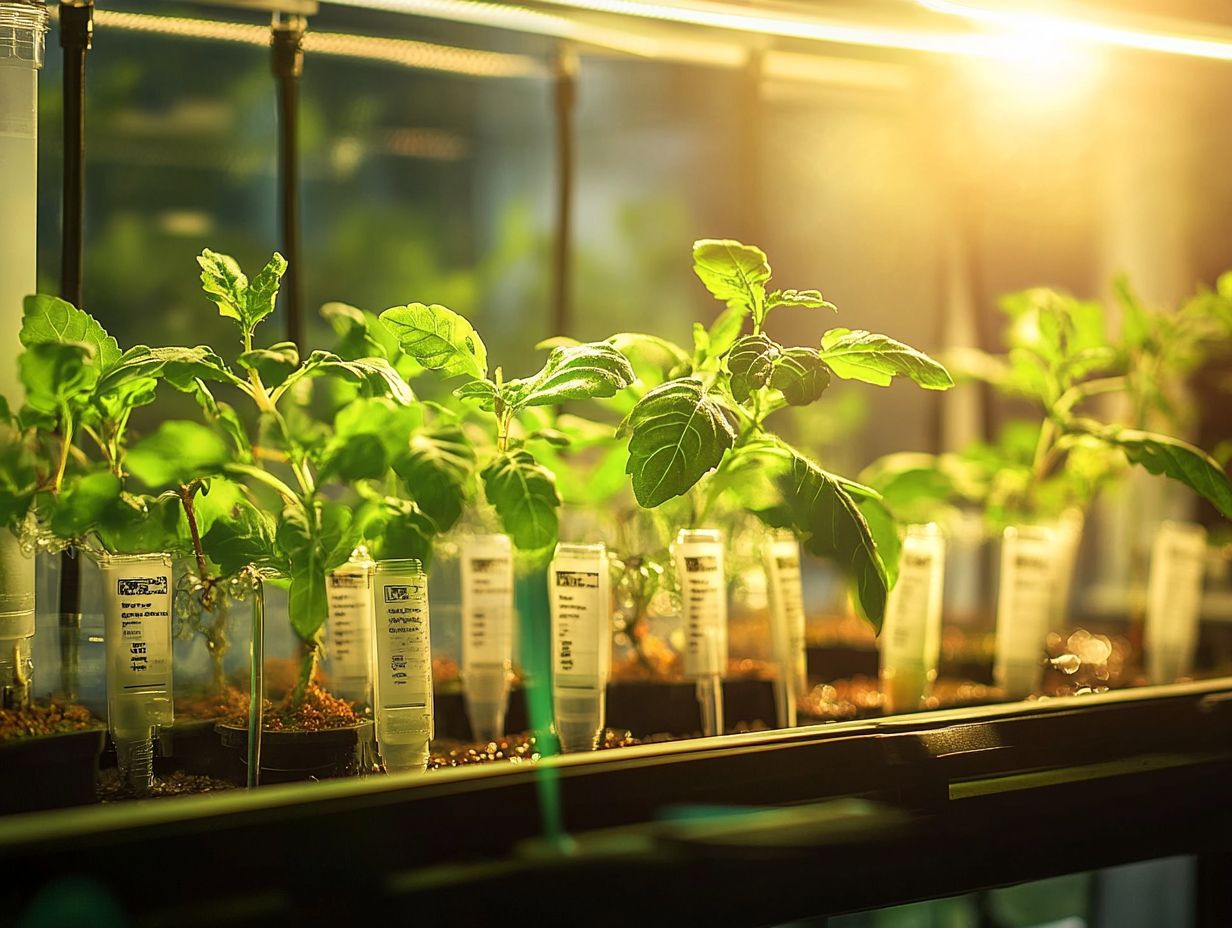
Nutrients are vital for healthy plants. In hydroponic gardening, you ll encounter a variety of nutrients, including macronutrients and micronutrients, both essential for plant functions. These nutrients need to be delivered through a carefully crafted nutrient solution.
Macronutrients like nitrogen, phosphorus, and potassium are primary catalysts for growth and development. Micronutrients such as iron, manganese, and zinc support enzymes and metabolic processes.
To achieve optimal plant health, hydroponic fertilizers are typically formulated with balanced ratios of these nutrients. You ll find common blends designed for different plant types, whether leafy greens or fruit-bearing crops, addressing their distinct nutritional needs.
By using suitable sources like chelated minerals or organic compounds, you enhance nutrient availability. This promotes strong plant structure and maximizes your yields.
What Are the Most Common Nutrient Deficiencies in Hydroponic Plants?
Nutrient deficiencies in hydroponic plants often show visible signs, like yellowing leaves or stunted growth. It s crucial to identify and tackle these issues promptly.
When plants lack essential nutrients such as nitrogen, phosphorus, or potassium, they display distinct signs. For example, nitrogen deficiency often results in yellowing leaves. Insufficient phosphorus can lead to poor root development and unusually dark green foliage.
These deficiencies hinder plant growth and can also reduce yield and overall vitality. Regularly monitor nutrient levels and adjust your solutions as needed, incorporating specific supplements to target the lacking nutrients.
By maintaining a balanced nutrient profile, you can foster healthier plants and fully optimize your hydroponic systems!
How Can One Ensure Proper Nutrient Uptake in Hydroponic Plants?
To ensure your plants absorb nutrients well, maintain a balanced nutrient solution, optimal oxygen levels, and appropriate electrical conductivity for efficient nutrient management.
Achieving this balance requires attention to various parameters that influence plant health and growth. Regularly monitoring electrical conductivity (EC) allows you to gauge nutrient concentration, while ensuring adequate oxygen levels promotes root respiration and nutrient absorption.
As you cultivate in hydroponics, adjusting the nutrient solution becomes essential. Adding more nutrients as your plants mature can significantly enhance their vitality.
Using air stones effectively boosts oxygen levels in your reservoirs, ensuring roots receive the perfect balance for maximum efficiency. Keeping a checklist of these parameters is invaluable for optimizing your hydroponic system.
What Are the Benefits of Using Organic Nutrients in Hydroponic Gardening?
Organic nutrients offer great benefits for hydroponic gardening. They improve nutrient balance, enhance plant health, and significantly reduce environmental impact compared to synthetic fertilizers.
These advantages arise from organic options fostering healthier microbial activity in the substrate, leading to superior nutrient absorption. Integrating organic nutrients into your system creates a resilient ecosystem, nurturing root development and boosting yields.
Embracing organic nutrients benefits your plants and enhances soil structure over time, ensuring improved aeration and water retention. For your hydroponic systems, consider incorporating:
- Compost teas
- Fish emulsion
- Seaweed extracts
These choices provide a broad spectrum of essential micronutrients that promote vigorous growth while nurturing a harmonious relationship with nature.
How Can One Troubleshoot Nutrient Problems in Hydroponic Gardening?
Troubleshooting nutrient problems in hydroponic gardening requires a methodical approach that helps identify common mistakes and implement effective nutrient management strategies to prevent plant diseases.
Start by closely observing your plants for visible symptoms, such as yellowing leaves or stunted growth. These signs provide crucial clues about potential nutrient deficiencies.
Once you’ve noted the symptoms, it’s essential to test your nutrient solutions for pH and a measure of how well water can carry an electric current, which indicates nutrient levels. This will help pinpoint any imbalances affecting your plants.
After conducting these tests, adjust the nutrient mix to meet the specific needs of your plants. Maintaining rigorous sanitation practices is also crucial. Regularly clean your tools and equipment to prevent recurring issues and ensure a healthier growing environment for your hydroponic garden. Additionally, be mindful of common mistakes to avoid in hydroponics to optimize your results.
Frequently Asked Questions
1. What are the top 10 nutrient mistakes in hydroponic gardening?
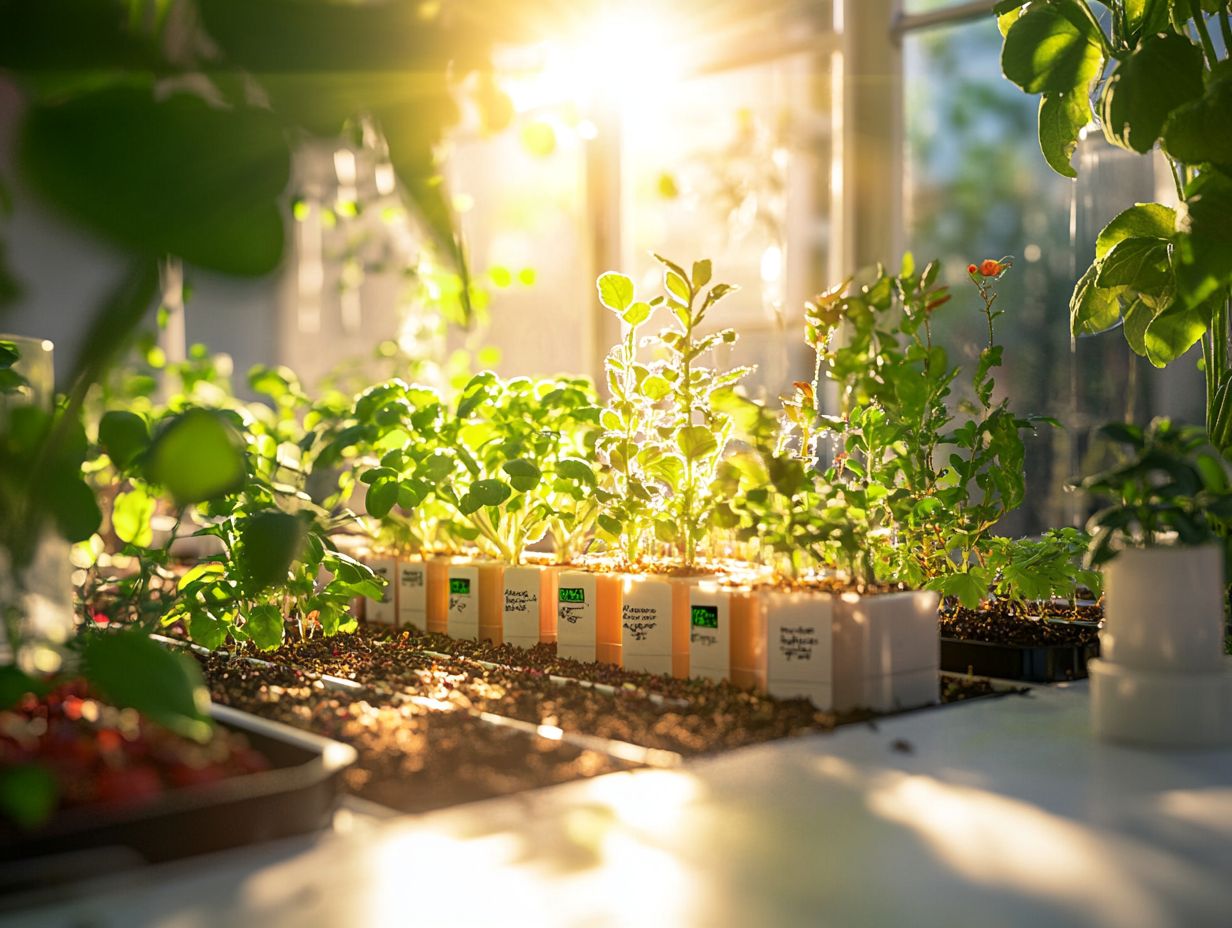
The top 10 nutrient mistakes in hydroponic gardening include:
- Using incorrect nutrient ratios
- Not monitoring pH levels
- Over or underfeeding plants
- Using low-quality nutrients
- Not adjusting nutrient levels for different plant stages
- Not providing enough oxygen to the roots
- Neglecting to flush the system regularly
- Not properly maintaining nutrient solution temperature
- Using tap water without removing chlorine and other impurities
- Not using a balanced nutrient solution
2. Why is using incorrect nutrient ratios a common mistake in hydroponic gardening?
Using incorrect nutrient ratios can lead to nutrient deficiencies or toxicities, affecting plant growth and overall health. Follow the recommended nutrient ratios for specific plants to ensure they receive the proper balance of macro and micronutrients.
3. How does monitoring pH levels impact plant growth in hydroponic gardening and what are its implications for hydroponic systems?
pH levels directly affect nutrient uptake in plants. If pH is too high or low, it can hinder nutrient absorption, resulting in deficiencies. Regular monitoring and adjustment of pH levels are crucial for healthy plants in hydroponic gardening.
4. What are the consequences of over or underfeeding plants in hydroponic gardening, and how can common mistakes be avoided?
Overfeeding can cause nutrient burn, while underfeeding may lead to stunted growth and deficiencies. It’s vital to follow recommended feeding schedules and adjust based on plant growth and development.
5. Can using low-quality nutrients affect plant growth in hydroponic gardening, and what are the implications for sanitation practices?
Yes, low-quality nutrients may contain impurities or inconsistent levels, harming plant growth and leading to deficiencies or toxicities. Invest in high-quality nutrients they are key to your plants’ success!
6. How does oxygen play a role in hydroponic gardening, particularly in relation to root rot and nutrient management?
Oxygen is essential for healthy root growth. Without enough oxygen, roots can become waterlogged and susceptible to root rot. Ensure adequate aeration in the nutrient solution to help oxygen reach the roots.
Ready to elevate your hydroponic gardening game? Explore more tips and resources to ensure your plants thrive!


